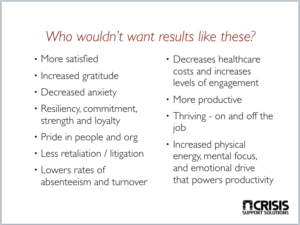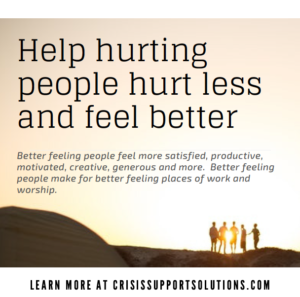How much are the people in your organization worth?
Break it down by dollars and cents. How much is your organization paying in salaries, training, healthcare, work space, equipment, etc. to ensure productivity and performance? Consider this, how much is lost because of infighting, indecision, isolation, selfishness, lack of accountability, immaturity and more?
I’ve spent a lot of time “pitching” support programs to executives – and there’s always a few in the room that have their eyes on the bottomline:
- How much to start-up?
- How much to maintain?
- What’s the return on investment?
- Is it worth the investment?
When first starting out, I would secretly judge leaders asking these questions. From their questions, I would assume they were “heartless” – unconcerned with those stressed and struggling. From my high horse, I would make a heart-felt plea about how helping people is the right thing to do. It shouldn’t matter the cost. The return on investment was saving lives (then I would dramatically add) and you can’t put a price on that.
Well, turns out, you can. Providing peer support is quantifiable. The fact is: starting (or enhancing) an organized, informal support program is a low-cost, high-yield investment.
Here’s how:
1. Peers provide timely and “on-site” response to help colleagues stay at work. Some supervisors prefer that employees keep feelings “in check” so that personal matters do not disrupt work performance.
Yet, the simple fact is: everywhere you go – there you are. Human beings are not robots. We have feelings – and they are with us until resolved. Some are more successful than others at denying, compartmentalizing or repressing, but after a while, negative feelings are often unfairly displaced on supervisors, coworkers and others in their way.
Peer support provides a confidential space for the employee / member to freely vent without worry of judgment, ridicule or retaliation. It also allows the peer an opportunity to validate concerns, reframe distortions, explore options, encourage decision-making and more. After venting, people usually feel catharsis. After discussing options, people usually feel clarity. After making a decision, people usually feel empowered. These outcomes leave a person feeling better. And that’s the goal of peer support: help hurting people hurt less and feel better.
Having an in-house peer support program means colleagues connecting with a peer in order to vent frustrations before it escalates, generate their own solutions and feel better more quickly.
2. Research confirms what we’ve known intuitively: compassion in the workplace delivers positive results (to include, bolstering the bottomline).
The American Psychological Association (APA) released a study in 2012 stating: “Employees who feel valued are more likely to report better physical and mental health, as well as higher levels of engagement, satisfaction and motivation, compared to those who do not feel valued by their employers.”
In an interview with Annuals Review, Professor of Business Administration and Psychology, Dr. Jane Dutton, discovered compassion at work lowers rates of absenteeism and turnover, decreases healthcare costs and increases levels of engagement. Dr. Dutton also found compassion to “increase positive feelings for all” by fostering resiliency, building commitments, strengthening loyalty and attachments.
In 2014, Harvard Business Review (HBR) published an article stating: “Employees who felt they worked in a loving, caring culture reported higher levels of satisfaction and teamwork [and] showed up to work more often…People who worked in a culture where they felt free to express affection, tenderness, caring, and compassion for one another were more satisfied with their jobs, committed to the organization, and accountable for their performance.”
While other programs, such as wellness programs, focus on physical health, a peer support program focuses on the whole person. Peers are trained to address a myriad of concerns – such as work stress, relationship stress, grief / loss, alcohol / substance abuse, suicide intervention and more. Whether a colleague is in crisis or just having a difficult day, peers are trained to lean in, listen up and provide a compassionate presence that communicates value and worth to all involved.
3. No regrets reported. Of those who have approved support programs for their organization, we have yet to find one leader who has regretted the decision and terminated the program. Instead, executives report demonstrations of compassion and support have proven beneficial in their organization.
In fact, the only regrets I hear are concerning lack of support; such as the case with (then) Corporal of the Virginia State Police department after responding to the first Virginia Tech shooting. During a “lessons learned” at the Federal Law Enforcement Training Center (FLETC) symposium, Steven W. Flaherty explained his only regret in response to the shooting was that they did not think to offer emotional support to officers following the investigation. Col. Flaherty later shared with me that nearly six months to the day of the shooting, half of Virginia Tech Police Officers “walked off” the job.
“We have to do better,” he said, “taking care of our own.”
Col. Flaherty is not alone. As rates of suicide continue to rise (along with concerns of alcoholism, substance abuse, domestic violence and more), peer programs are gaining momentum as an accepted and effective tool for assessing and addressing concerns. As such, the International Association of Chiefs of Police (IACP), the Substance Abuse and Mental Health Services Administration (SAMHSA), Veterans Affairs (VA) Administration, the U.S. Department of Justice (DOJ), the National Institute of Health (NIH) and others are utilizing peer support within their own agencies / departments.
In fact, Federal and state governments are passing legislation to encourage peer support (peer mentoring / peer counseling). In 2017, President Trump signed into law the Law Enforcement Mental Health Wellness Act of 2017 creating funding initiatives to support officer wellness. In 2018, Georgia passed HB 703, providing peer support and post-incident seminars to all first responders at all levels of government.
4. Saves lives … and addresses toxic culture. There’s no doubt that peer support services saves lives. I’ve witnessed it myself. I’ve heard from others sharing positive results, not just of successful suicide intervention, but by redirecting a colleague towards a healthier outcome. Peer support services walk people back from the “ledge” of hopelessness and uncertainty, reminding them that they are loved, valued and never alone.
More than a feel-good program, peer support is a productivity-boosting, conflict-resolving, outlook-improving, bottomline-benefiting program endorsed by agencies / organizations at federal, state and local levels.
While we explore the merits (and liability) of peer support programs, the fact remains, hurting people hurt people. Hurting people hurt themselves. Hurting people hurt organizations.
Intentionally or unintentionally, hurting people behave in passive aggressive and/or aggressive aggressive ways that create conflicts, promote gossip, spread negativity, criticize leaders, cause isolation and more. This is known as a “toxic work environment”.
By helping hurting people hurt less and feel better, peer support not only begins to change the climate of a workplace, but organizational culture as well.
Is peer support is right for your organization?
Take our online assessment: https://forms.gle/VHQm4LvUj8Uf2WTQ6



